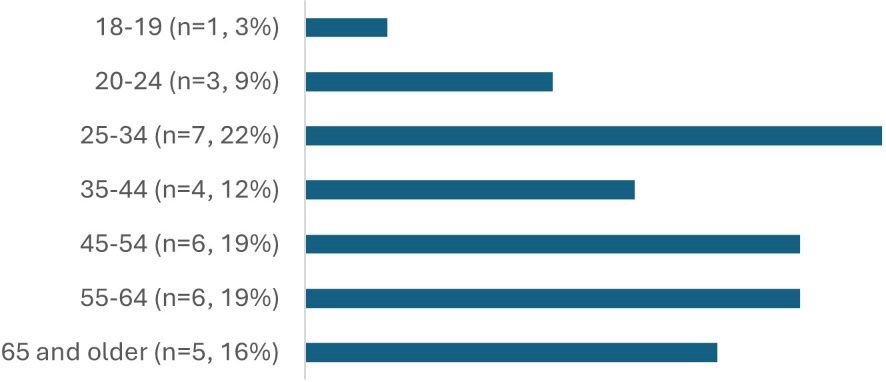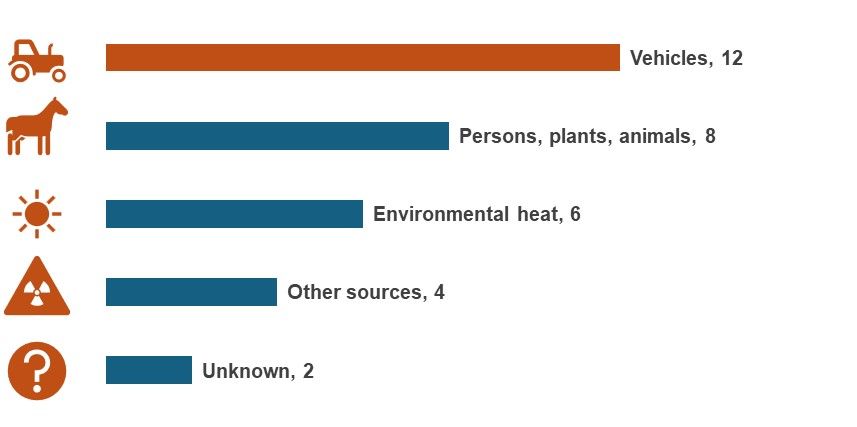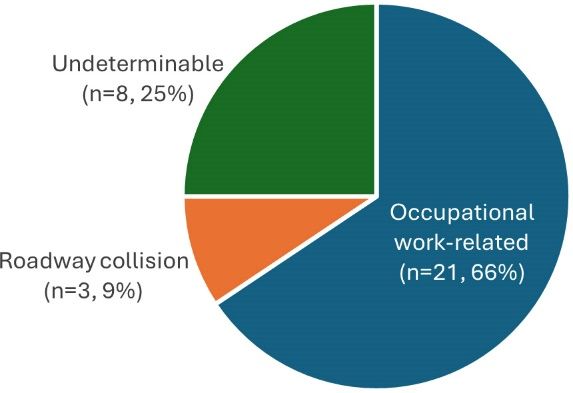Introduction
Agriculture, Forestry, and Fishing (AgFF) is one of the most hazardous industrial sectors in the United States. According to the US Bureau of Labor Statistics (BLS) annual Census of Fatal Occupational Injuries (CFOI) data, the fatal work injury rate was 23.5 deaths per 100,000 full-time workers in farming, forestry, and fishing occupations, compared to a rate of 3.7 deaths per 100,000 full-time workers for all industries (total) (BLS 2023a; BLS 2023b). Agricultural operations are not only hazardous for the workers, but also for the nonworkers such as family members, visitors, and other drivers sharing the same roads with farm equipment. These injuries usually are not captured by traditional injury surveillance methods.
The purpose of this report is to summarize Florida’s AgFF-related fatalities for 2022 and 2023. This report helps to identify hazards and risks associated with AgFF. The information from this report may be used by Extension educators, researchers, agricultural employers, and anyone interested in injury statistics. This report can be used for developing injury prevention plans.
Method
The data used in this report were from news clippings, obituaries, and death certificates. The death certificates were obtained from the Bureau of Vital Statistics at the Florida Department of Health (FL DOH 2024). Fatalities included in this report are:
- Accidents
- Accidental drug overdoses (if the place of injury was the worksite)
- Workplace homicides
- Workplace suicides
The BLS’s Occupational Injury and Illness Classification System (OIICS) (BLS 2012) was utilized to classify each fatality according to the primary source of injury, the secondary source of injury, and the event or exposure associated with the injury. The primary source of injury or illness identifies the object, substance, bodily motion, or exposure that directly produced or inflicted the injury. The event or exposure describes the way the source of injury or illness produced or inflicted the injury or illness. This report only shows primary injury sources.
Results
There were 39 fatalities recorded in Florida in 2022 (n=21) and 2023 (n=18). Thirty-two fatalities were related to agriculture, three were related to forestry, and four were related to fishing industries.
Agricultural Fatalities
A total of 32 fatalities were reported related to the agricultural industry in 2022 and 2023 in Florida. Most victims were male (91%) and in the 18–64 age group (84%) (Figure 1). The manner of death was listed as “accident” for 29 victims (91%). Three fatalities (9%) were reported as “suicide.” Ten victims (31%) were identified as Hispanic, and the cause of death for all was classified as an accident.

Credit: Serap Gorucu, UF/IFAS
Injury Source
Figure 2 shows the injury sources for agricultural fatalities. Vehicles caused 38% (n=12) of the fatalities. Ten fatalities were farm-tractor-related. Other vehicles included forklifts and farmworker buses. Cattle and horses caused fatalities for four individuals. Environmental heat caused six fatalities. Three fatalities were suicides. Other fatality sources were machinery, drug abuse, skid steer, and a sick employee.

Credit: Serap Gorucu, UF/IFAS
Events Leading to Fatalities
The following event/exposure categories contributed to the agricultural fatalities.
- Transportation incidents (n=16, 50%): These involve vehicles, animals used for transportation purposes, and powered industrial vehicles or powered mobile industrial equipment. Transportation-related fatalities were:
- Non-roadway incidents (n=6)
- Roadway incidents (n=4)
- Pedestrian incidents (n=4)
- Rail vehicle incidents (n=1)
- Animal transportation incidents (n=1)
2. Exposure to harmful substances and environments (n=7, 22%): Five fatalities were related to environmental heat exposure and one victim died after direct contact with high-voltage electricity.
3. Violence and other injuries by persons or animals (n=5, 16%): Three of these fatalities were intentional self-harm. One victim died after being kicked by a bull, and one victim was killed by a drug overdose.
4. Contact with objects and equipment (n=2, 6.3%): One victim died after being caught between train containers, and another died after being struck by a falling tractor.
5. Other events (n=2, 6.3%): One employee died of heart attack, and one died after a fall at work.
Types of Agricultural Fatalities
The Farm and Agricultural Injury Classification (FAIC) code (ASAE S575.3) is used to separate occupational work-related incidents (ASAE 2020). FAIC codes allow the identification of work cases as well as unique situational exposures in production agriculture, such as nonworkers in work environments. In many cases, there was not enough detailed information to make the code assignment; for those cases, the “Undeterminable” category was used (e.g., when a tractor in a roadway crash injuring the tractor operator could be coded as “undeterminable” because it was not clear if the operator was traveling for agricultural work at the time of the incident). Additionally, workplace suicides, homicides, and accidental overdoses were classified under the “Undeterminable” category.
In 2022 and 2023, most of the fatalities were occupational work-related fatalities (66%); 9% of the fatalities involved agricultural roadway hazards to nonworkers (Figure 3). Nonworker victims were the other occupants of the vehicle who were killed in a roadway crash involving farm equipment.

Credit: Serap Gorucu, UF/IFAS
Forestry- and Logging-Related Fatalities
Three forestry-related fatalities were identified in 2022 and 2023, two of which involved transportation incidents and one of which involved machinery-related contact. Two fatalities were related to a roadway incident involving logging trucks, and one victim was killed after being crushed by logs that came off a truck.
Fishing-Related Fatalities
Over the study years, there were four fatalities related to the fishing industry in Florida. Two victims drowned, and two victims’ fatalities were related to drug overdose and self-inflicted intentional injury.
Summary and Recommendations
The findings of this report indicate a wide range of causes for AgFF fatalities in Florida. These fatalities did not involve only workers, but also nonworkers such as people on roadways. A few recommendations and resources to prevent AgFF-related injuries are listed below.
- Transportation incidents were responsible for more than half of the fatalities. When using tractors or agricultural vehicles on roadways, operators must check the lighting and marking features of their vehicles and make sure they meet the lighting and marking standards (ANSI/ASAE 279.14). Safety tips for agricultural vehicles on public roads are available at http://www.abe.ufl.edu/agsafety. Ask IFAS publication ABE302 provides a summary of the ANSI/ASAE Standard S279.18 (https://edis.ifas.ufl.edu/publication/AE175).
- Tractors were the primary source of non-roadway transportation incidents. Tractor operators must wear seat belts if tractors are equipped with rollover protective structures (ROPS). Additionally, when operating near canals, operators should leave enough space between the tractors and the edges of the canals. For more information on safe tractor operations, consult Ask IFAS publication AE599 (Gorucu et al. 2024) (https://edis.ifas.ufl.edu/publication/AE599).
- Some key points to prevent heat-stress-related injuries include increasing rest breaks, providing adequate hydration, ensuring proper acclimatization by gradually increasing workers' exposure to heat, and maintaining a heat alert program. For a comprehensive list of recommendations, refer to the National Institute for Occupational Safety and Health (NIOSH) (https://www.cdc.gov/niosh/heat-stress/recommendations/index.html) and the Occupational Safety and Health Administration (OSHA) (https://www.osha.gov/heat-exposure/prevention).
- Mental-health- and opioid-use-related training sources and links are available through the Southeastern Coastal Center for Agricultural Health and Safety (SCCAHS) (http://www.sccahs.org/index.php/ag-health-safety-topics/opioid-abuse/).
- Logging trucks on roadways pose safety hazards to the vehicles sharing the same roads. Vehicle operators need to keep a safe following distance around logging trucks. Ask IFAS publication AE598 summarizes logging truck-related crashes in Florida and provides links and safety resources (https://edis.ifas.ufl.edu/publication/AE598).
References
ASABE. 2020. “Farm and Agricultural Injury Classification (FAIC) Code.” Accessed April 12, 2021. https://elibrary.asabe.org/abstract.asp?aid=51197&t=3&dabs=Y&redir=&redirType=
Bureau of Labor Statistics (BLS). 2023a. “Number and Rate of Fatal Work Injuries, Civilian Workers, by Major Occupational Group 2022.” Accessed February 14, 2024. https://www.bls.gov/charts/census-of-fatal-occupational-injuries/number-and-rate-of-fatal-work-injuries-by-occupation.htm
Bureau of Labor Statistics (BLS). 2023b. “Economic News Release, Census of Fatal Occupational Injuries Summary, 2012.” Accessed February 14, 2024. https://www.bls.gov/news.release/cfoi.nr0.htm
Bureau of Labor Statistics (BLS). 2012. “Occupational Injury and Illness Classification System (OIICS) Code Trees v2.01.” https://wwwn.cdc.gov/wisards/oiics/Trees/MultiTree.aspx?Year=2012
Florida Department of Health. 2024. “Certificates.” https://www.floridahealth.gov/certificates/certificates/
Gorucu, S., and C. Brown. 2021. “Agricultural Safety Hits the Road: Safety Tips for Agricultural Vehicles on Public Roads.” Florida Agricultural Safety and Health Program. https://abe.ufl.edu/agsafety/program-areas/
Gorucu, S., C. J. Lehtola, and C. M. Brown. 2024. “Safe Tractor Operations: Foundations of Tractor Safety: AE599, 6/2024.” EDIS 2024 (3). https://doi.org/10.32473/edis-ae599-2024
Gorucu, S., M. Moore, and N. Bliznyuk. 2024. “Roadway Safety: Logging Truck-Related Crashes in Florida: AE598, 2/2024.” EDIS 2024 (1). https://doi.org/10.32473/edis-ae598-2024